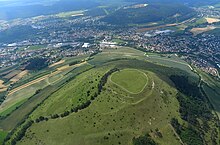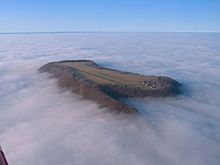Hilltop settlement


The term hill settlement describes a prehistoric type of settlement and describes the topographical location of a settlement without presupposing the presence of a fortification . Within the meaning of Jörg Biel are
“[...] those settlements that are set apart from their surroundings due to differences in altitude and are somewhat protected by the natural terrain or that favor fortification [understood]. The remoteness is to be assessed more strongly than height differences. "
Rafael von Uslar took a similar view of the hill settlements as such:
"Elevations [...] which clearly stand out from their surroundings with more or less steep flanks [understands]; d. H. On the one hand, a stronger relief terrain is sufficient, as can also occur in the so-called lowlands, so that hillside settlements are not limited to the low and high mountains; [...] "
Other concepts define the type of settlement, in addition to the exposed location due to its remote location, with an elevation of 20 to 30 meters from the surrounding area on at least three sides. Depending on the location, a distinction is made between the various types, on a summit, on a terrace edge or on a spur.
This type of settlement is associated with characteristics such as defensibility, central location function and representative, complex social structures. In addition to the geographical location, the defensibility of a hilltop settlement mostly results from the presence of a fortification. Since high-altitude settlements, due to a largely pronounced settlement favor, usually have several phases of settlement, periodization and dating of the fortifications and their correlation with the interior and exterior development are only possible with systematic research. Corresponding differentiations have so far been made, for example, at the Late Bronze Age to Early Iron Age hill settlements on the Schalkenburg near Quenstedt , district of Mansfeld-Südharz .
Examples of hilltop settlements from different epochs
- Neolithic : Schalkenburg
- Bronze Age : Bullenheimer Berg - Bronze Age fortifications near Bernstorf - Heunischenburg - Farrenberg
- Iron Age : Schalkenburg - Glauberg - Heuneburg - Ipf
- Migration period : Runder Berg - Zähringer Burgberg - Gelb Bürg - Houbirg - Reisberg - Wettenburg - Dünsberg - Geißkopf
See also
- Oppidum : Celtic type of settlement from the late Iron Age
- Migration period hilltop settlement
literature
- Jörg Biel : Prehistoric hilltop settlements in southern Württemberg-Hohenzollern. Research and reports on prehistory and early history in Baden-Württemberg. Volume 24. Stuttgart 1987.
- Z. Smrž : high altitude locations of the Knoviz culture in north-west Bohemia. Vinné lokality knovízské kultury v severozápadních echách. In: Památky Archaeologické Volume 86, 1995, pp. 38-80.
- Sandra Sosnowski : New insights into the construction and reconstruction of the circular palisade on the "Schalkenburg" near Quenstedt, district of Mansfeld-Südharz. In: Harald Meller , François Bertemes (Hrsg.): Neolithic circular moats in Europe (= conferences of the State Museum for Prehistory in Halle. Volume 8). Halle (Saale) 2012, pp. 121–134.
- Sandra Sosnowski: The polycultural Quenstedt site, hall “Schalkenburg”, Ldkr. Mansfeld-Südharz. New results on settlement structure and sequence. In: Archeology in Saxony-Anhalt. Volume 7, 2014, pp. 55-69.
- Sandra Sosnowski: The fortified settlement "Schalkenburg" near Quenstedt District Mansfeld-Südharz. A place of discovery in the area of tension between the large Late Bronze to Early Iron Age cultural complexes in the north-eastern Harz foreland. In: Thomas Doppler , Britta Ramminger , Dirk Schimmelpfennig (eds.): Borders and border areas? Examples from the Neolithic and Bronze Age (= focus on the Neolithic. Volume 2). Loogh 2011, pp. 113-130.
- Rafael von Uslar : Castle III. Archaeological In: Heinrich Beck , Herbert Jankuhn , Kurt Ranke , Reinhard Wenskus (Eds.): Brunnen- Chronologie (= Reallexikon der Germanischen Altertumskunde ), Volume 4, Berlin, New York 1981, ISBN 3-11-006513-4 , p. 124-197.